Arboreta
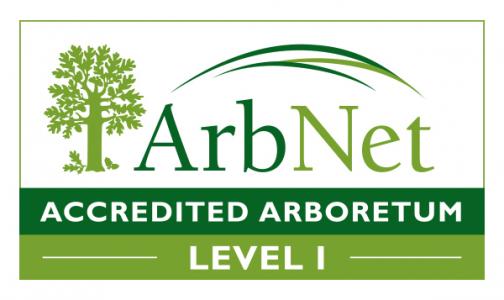
Vogelei Park, a Hoffman Estates Park District (HEParks) park, located at the corner of Golf and Higgins Roads in Hoffman Estates, was recognized internationally on July 16, 2020, as a Level 1 Accredited Arboreta through the ArbNet Arboretum Accreditation Program. This is the only international program of accreditation for arboreta. Vogelei Park joins 404 other accredited parks across 32 countries, who meet the criteria for specimen number, future planning, education, and preservation of woody plants. There are 2,037 arboreta worldwide registered with The Morton Register through the Morton Arboretum.
An arboretum is a botanical garden focused on trees. These intentionally developed living tree museums help engage and educate the public on the importance of tree species preservation.
The Arboretum at Vogelei Park
HEParks chose Vogelei Park as the site for an arboretum due to its historical importance to the community. As the original headquarters for HEParks, this site housed both the parks and the recreation departments and the first community center for the developing community of Hoffman Estates. The district felt that this park was an appropriate site to pay homage to the many hands over the years that helped secure and create the outdoor spaces found throughout Hoffman Estates.
HEParks focused on completing the accreditation over the past two years. However, the development of the arboretum goes back before the founding of the park district. Within Vogelei Park are a few old cottonwood trees from the original homestead acquired by the HEParks in 1969. Over the years, through efforts from community volunteer groups, memorial tree donors, and district staff, the collection of trees expanded to include over 25 different species of native and non-native woody plant specimens.
The collection of woody plants at Vogelei Park has been carefully curated through the years to highlight the landscape while providing the plants’ best growing conditions. Specimens were thoughtfully placed based on their growing preferences, blooming periods, and color. HEParks also planted species from other regions of the United States to highlight trees that residents may never get a chance to see otherwise. HEParks is currently developing informational signage throughout the park, highlighting the horticultural specimens.
This accreditation would not have been possible without the hard work and planning of HEParks staff over the past 50+ years who have preserved and curated green spaces for the community to enjoy, the Boy Scouts and Girls Scouts of America, donors of memorial trees and the Board of Commissioners and Administration at HEParks.
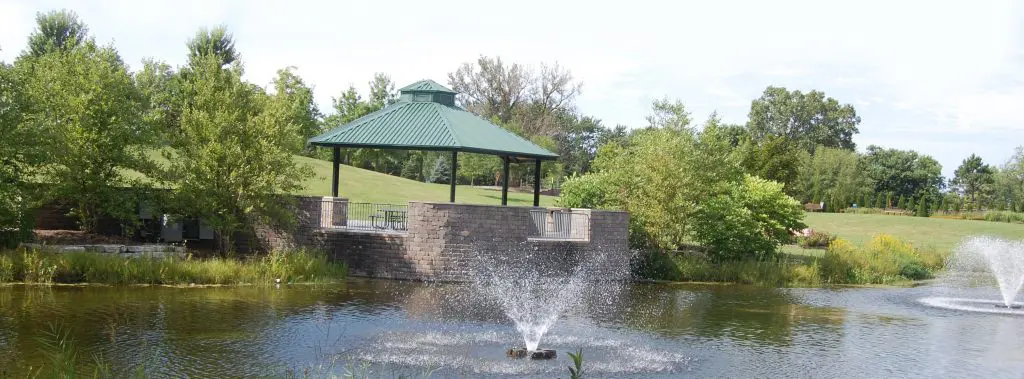
Trees Species within Vogelei Park
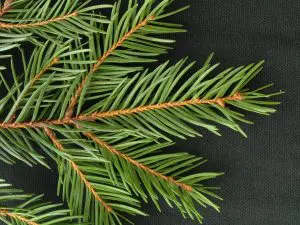 Picea rubens, commonly known as red spruce, is a species of spruce native to eastern North America, ranging from eastern Quebec and Nova Scotia, west to the Adirondack Mountains and south through New England along the Appalachians to western North Carolina.
Picea rubens, commonly known as red spruce, is a species of spruce native to eastern North America, ranging from eastern Quebec and Nova Scotia, west to the Adirondack Mountains and south through New England along the Appalachians to western North Carolina. Gymnosperm Database
Wikipedia entry.
Scientific name: Picea rubens
Higher classification: Spruce
Conservation status: Least Concern (Population increasing) Encyclopedia of Life
Rank: Species
Family: Pinaceae
Kingdom: Plantae
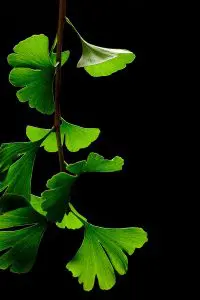 Ginkgo biloba, commonly known as ginkgo or gingko, also known as the maidenhair tree, is the only living species in the division Ginkgophyta, all others being extinct. It is a very old species, with some fossils dating back 270 million years.
Ginkgo biloba, commonly known as ginkgo or gingko, also known as the maidenhair tree, is the only living species in the division Ginkgophyta, all others being extinct. It is a very old species, with some fossils dating back 270 million years. Scientific name: Ginkgo biloba
Conservation status: Endangered Encyclopedia of Life
Higher classification: Ginkgo
Rank: Species
Eaten by: Supersaurus, Lambeosaurus
Wikipedia entry
Gymnosperm Database
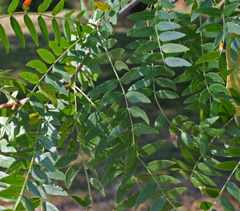 The light, dappled shade cast by the lacy foliage of this attractive tree is only one of its virtues. It also is durable and adaptable, tolerating a wide range of soil conditions as well as drought, and road salt, and has lovely yellow fall color. The native species of honey-locust have large thorns on their stems and bark. For this reason, thornless honey locust, also known as Gleditsia triacanthos f. inermis, is most commonly sold.
The light, dappled shade cast by the lacy foliage of this attractive tree is only one of its virtues. It also is durable and adaptable, tolerating a wide range of soil conditions as well as drought, and road salt, and has lovely yellow fall color. The native species of honey-locust have large thorns on their stems and bark. For this reason, thornless honey locust, also known as Gleditsia triacanthos f. inermis, is most commonly sold. Botanical name: Gleditsia triacanthos f. inermis
All Common Names: thornless honey-locust, common honey-locust, honeylocust, thornless honeylocust
Morton Arboretum Link
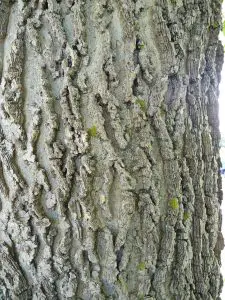 It is also known as the nettle tree, sugarberry, beaverwood, northern hackberry, and American hackberry. The common hackberry is a medium-sized tree, 9 to 15 meters (30 to 50 ft) in height,[3] with a slender trunk. In the best conditions in the southern Mississippi Valley area, it can grow to 40 meters (130 ft). It has a handsome round-topped head and pendulous branches. It prefers rich moist soil but will grow on gravelly or rocky hillsides. The roots are fibrous and it grows rapidly.[5] In the western part of its range, trees may still grow up to 29 m (95 ft).[3] The maximum age attained by hackberry is probably between 150 and 200 years in ideal conditions.[3]
The bark is light brown or silvery gray, broken on the surface into thick appressed scales and sometimes roughened with excrescences; the pattern is very distinctive.[5] The remarkable bark pattern is even more pronounced in younger trees, with the irregularly-spaced ridges resembling long geologic palisades of sedimentary [layered] rock formations when viewed edge-wise [cross-section]. Coins as large as USA quarters can easily be laid flat against the valleys, which may be as deep as an adult human finger.
It is also known as the nettle tree, sugarberry, beaverwood, northern hackberry, and American hackberry. The common hackberry is a medium-sized tree, 9 to 15 meters (30 to 50 ft) in height,[3] with a slender trunk. In the best conditions in the southern Mississippi Valley area, it can grow to 40 meters (130 ft). It has a handsome round-topped head and pendulous branches. It prefers rich moist soil but will grow on gravelly or rocky hillsides. The roots are fibrous and it grows rapidly.[5] In the western part of its range, trees may still grow up to 29 m (95 ft).[3] The maximum age attained by hackberry is probably between 150 and 200 years in ideal conditions.[3]
The bark is light brown or silvery gray, broken on the surface into thick appressed scales and sometimes roughened with excrescences; the pattern is very distinctive.[5] The remarkable bark pattern is even more pronounced in younger trees, with the irregularly-spaced ridges resembling long geologic palisades of sedimentary [layered] rock formations when viewed edge-wise [cross-section]. Coins as large as USA quarters can easily be laid flat against the valleys, which may be as deep as an adult human finger. Scientific name: Celtis occidentalis
Higher classification: Hackberries
Family: Cannabaceae
Rank: Species
Kingdom: Plantae
Order: Rosales
Wikipedia
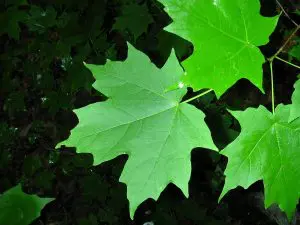 Sugar maple is best known for being the primary source of maple syrup and for its brightly colored fall foliage.
Sugar maple is best known for being the primary source of maple syrup and for its brightly colored fall foliage.Sugar Maple History
In 1663, chemist Robert Boyle informed the Europeans about the tree in the new world that produced a sweet substance. John Smith was among the first settlers who remarked about the Native Americans’ sugar processing and the fact that they used the product for barter. They also used the inner bark to make a tea to treat coughs and diarrhea.
Other historic uses included making soap from its ashes, using the bark as a dye, drinking the sap as a spring tonic and taking the syrup for liver and kidney problems.
During the 2001 baseball season, Barry Bonds switched from the traditional ash wood baseball bat to one made of maple and hit 73 home runs—a new record!
The Sugar maple is the state tree of the US states of New York, Vermont, West Virginia and Wisconsin. It can be found on the Vermont state quarter. Arbor Day Foundation
Wikipedia
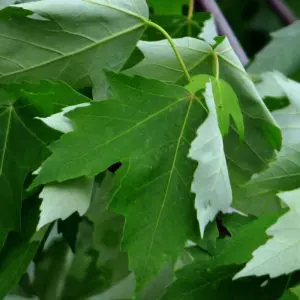 Acer saccharinum, commonly known as silver maple, creek maple, silverleaf maple,soft maple, large maple, water maple, swamp maple,, or white maple, is a species of maple native to the eastern and central United States and southeastern Canada. It is one of the most common trees in the United States.
Acer saccharinum, commonly known as silver maple, creek maple, silverleaf maple,soft maple, large maple, water maple, swamp maple,, or white maple, is a species of maple native to the eastern and central United States and southeastern Canada. It is one of the most common trees in the United States.Scientific name: Acer saccharinum
Family: Sapindaceae
Order: Sapindales
Rank: Species
Higher classification: Maple
Lifespan: 130 years usda.gov
Wikipedia
Morton Arboretum
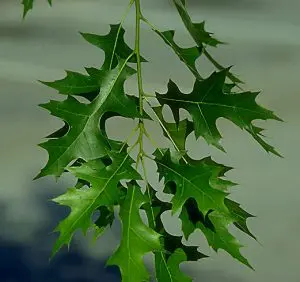 Quercus palustris, the pin oak or swamp Spanish oak, is an oak in the red oak section. Pin oak is one of the most commonly used landscaping oaks in its native range due to its ease of transplant, relatively fast growth, and pollution tolerance. Its distinctive shape is considered unique among hardwoods. Juvenile trees retain their leaves during the winter.
Quercus palustris, the pin oak or swamp Spanish oak, is an oak in the red oak section. Pin oak is one of the most commonly used landscaping oaks in its native range due to its ease of transplant, relatively fast growth, and pollution tolerance. Its distinctive shape is considered unique among hardwoods. Juvenile trees retain their leaves during the winter. Scientific name: Quercus palustris Family: Fagaceae Higher classification: Oak Rank: Species Section: Quercus sect. Lobatae Lifespan: 120 years Wikipedia
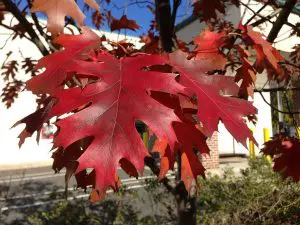 Quercus rubra, the northern red oak, is an oak tree in the red oak group. It is a native of North America, in the eastern and central United States and southeast and south-central Canada. It grows from the north end of the Great Lakes, east to Nova Scotia, south as far as Georgia, Mississippi, Alabama, and Louisiana, and west to Oklahoma, Kansas, Nebraska, and Minnesota.
Quercus rubra, the northern red oak, is an oak tree in the red oak group. It is a native of North America, in the eastern and central United States and southeast and south-central Canada. It grows from the north end of the Great Lakes, east to Nova Scotia, south as far as Georgia, Mississippi, Alabama, and Louisiana, and west to Oklahoma, Kansas, Nebraska, and Minnesota. Northern red oak is easy to recognize by its bark, which features ridges that appear to have shiny stripes down the center. A few other oaks have bark with this kind of appearance in the upper tree, but the northern red oak is the only tree with the striping all the way down the trunk
Scientific name: Quercus rubra
Rank: Species
Higher classification: Oak
Symbol of: New Jersey
Wikipedia entry
Morton Arboretum Link
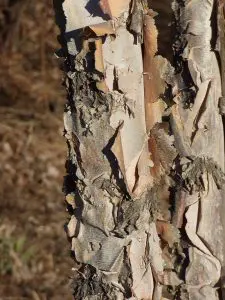 Betula nigra, the black birch, river birch or water birch, is a species of birch native to the Eastern United States from New Hampshire west to southern Minnesota, and south to northern Florida and west to Texas.
Betula nigra, the black birch, river birch or water birch, is a species of birch native to the Eastern United States from New Hampshire west to southern Minnesota, and south to northern Florida and west to Texas. Bark characteristics of the river birch differ during its youth stage, maturation, and old growth. The bark of a young river birch can vary from having a salmon-pink to brown-gray tint and can be described as having loose layers of curling, paper thin scales. As the tree matures, the salmon-pink color is exchanged for a reddish-brown with a dark grey base color. The scales on a mature tree lack the loose curling and are closely pressed into thick, irregular plates. These scales are slightly separated from the trunk and can shift outward to the side. Once the river birch ages past maturity, the scales become thicker towards the base of the trunk and are divided in deep furrows
Scientific name: Betula nigra
Rank: Species
Higher classification: Birch
Height: 40.00 to 70.00
Native Range: Eastern United States
Spread: 40.00 to 60.00 feet
Wikipedia Entry
Missouri Botanical Garden
 The Katsura is a deciduous tree with a moderate to fast growth rate. It is of medium height, making it better suited to the average urban or suburban property. The katsura is known for the yellow color of its fall leaves, it's rounded to pyramidal plant form and the attractive way that its heart-shaped leaves line up opposite one another along the branches. Of particular interest is the scent produced by the leaves in the autumn, resembling burnt brown sugar or cotton candy.
The Katsura is a deciduous tree with a moderate to fast growth rate. It is of medium height, making it better suited to the average urban or suburban property. The katsura is known for the yellow color of its fall leaves, it's rounded to pyramidal plant form and the attractive way that its heart-shaped leaves line up opposite one another along the branches. Of particular interest is the scent produced by the leaves in the autumn, resembling burnt brown sugar or cotton candy. Wikipedia Entry
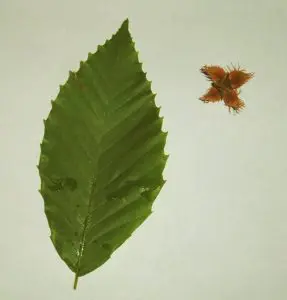 It is a deciduous tree growing to 20–35 m (66–115 ft) tall, with smooth, silver-gray bark. The leaves are dark green, simple and sparsely-toothed with small teeth that terminate each vein, 6–12 cm (2 1⁄4–4 3⁄4 in) long (rarely 15 cm, 6 in), with a short petiole. The winter twigs are distinctive among North American trees, being long and slender (15–20 mm (5⁄8–3⁄4 in) by 2–3 mm (0.079–0.118 in)) with two rows of overlapping scales on the buds. Beech buds are distinctly thin and long, resembling cigars; this characteristic makes beech trees relatively easy to identify. The tree is monoecious, with flowers of both sexes on the same tree. The fruit is a small, sharply-angled nut, borne in pairs in a soft-spined, four-lobed husk. It has two means of reproduction: one is through the usual dispersal of seedlings, and the other is through root sprouts (new trees sprout from the roots in different locations)
It is a deciduous tree growing to 20–35 m (66–115 ft) tall, with smooth, silver-gray bark. The leaves are dark green, simple and sparsely-toothed with small teeth that terminate each vein, 6–12 cm (2 1⁄4–4 3⁄4 in) long (rarely 15 cm, 6 in), with a short petiole. The winter twigs are distinctive among North American trees, being long and slender (15–20 mm (5⁄8–3⁄4 in) by 2–3 mm (0.079–0.118 in)) with two rows of overlapping scales on the buds. Beech buds are distinctly thin and long, resembling cigars; this characteristic makes beech trees relatively easy to identify. The tree is monoecious, with flowers of both sexes on the same tree. The fruit is a small, sharply-angled nut, borne in pairs in a soft-spined, four-lobed husk. It has two means of reproduction: one is through the usual dispersal of seedlings, and the other is through root sprouts (new trees sprout from the roots in different locations)Wikipedia Entry
Wildflower.org
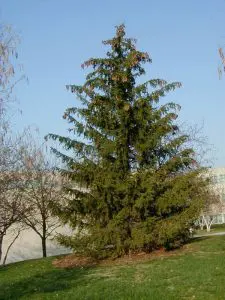 Picea abies, the Norway spruce or European spruce, is a species of spruce native to Northern, Central and Eastern Europe. It has branchlets that typically hang downwards, and the largest cones of any spruce, 9–17 cm long. Seed production begins when the tree is in its fourth decade and total lifespan is up to 300 years in its natural range in Europe. Introduced Norway spruces in the British Isles and North America have a much shorter life expectancy. As the tree ages, its crown thins out and lower branches die off.
Picea abies, the Norway spruce or European spruce, is a species of spruce native to Northern, Central and Eastern Europe. It has branchlets that typically hang downwards, and the largest cones of any spruce, 9–17 cm long. Seed production begins when the tree is in its fourth decade and total lifespan is up to 300 years in its natural range in Europe. Introduced Norway spruces in the British Isles and North America have a much shorter life expectancy. As the tree ages, its crown thins out and lower branches die off. Wikipedia
Missouri Botanical Garden
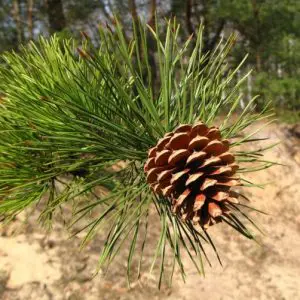 Pinus rigida, the pitch pine, is a small-to-medium-sized pine. It is native to eastern North America, from central Maine south to Georgia and as far west as Kentucky, and in two pockets along the St. Lawrence River in southern Quebec and Ontario. It is irregular in shape, branches are usually twisted and it does a poor job at self-pruning. The needles are in fascicles (bundles) of three, about 6–13 cm (2 1⁄4–5 in) in length, and are stout (over 1 mm (0.04 in) broad) and often slightly twisted. The cones are 4–7 cm (1 1⁄2–2 3⁄4 in) long and oval with prickles on the scales. Trunks are usually straight with a slight curve to them, they are covered in irregular, thick, large plates of bark.
Pinus rigida, the pitch pine, is a small-to-medium-sized pine. It is native to eastern North America, from central Maine south to Georgia and as far west as Kentucky, and in two pockets along the St. Lawrence River in southern Quebec and Ontario. It is irregular in shape, branches are usually twisted and it does a poor job at self-pruning. The needles are in fascicles (bundles) of three, about 6–13 cm (2 1⁄4–5 in) in length, and are stout (over 1 mm (0.04 in) broad) and often slightly twisted. The cones are 4–7 cm (1 1⁄2–2 3⁄4 in) long and oval with prickles on the scales. Trunks are usually straight with a slight curve to them, they are covered in irregular, thick, large plates of bark. Wikipedia Entry
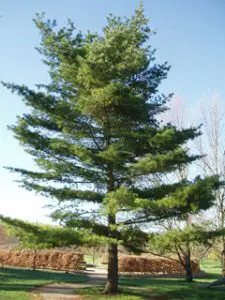
White Pine
During the age of sailing ships, tall white pines with high quality wood were known as mast pines. Marked by agents of the Crown in colonial times with the broad arrow, they were reserved for the British Royal Navy. Marking of large specimens by The Crown was very controversial in the colonies, and their de facto seizure was a point of great contention among the colonists and played a significant role in the events leading to the American Revolution. During the American Revolution it became a great sport for the patriots to see how many of the King’s trees one could cut down and haul off.
American Conifer Society
North Carolina Extension Gardener Plant Toolbox
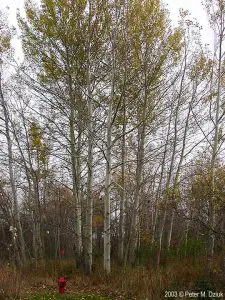 Populus grandidentata is a medium-sized deciduous tree native to North America, found mostly in the northeastern United States and southeastern Canada. Leaves are similar to Populus tremuloides, but slightly larger and having larger teeth.[2] The leaves tremble in the wind as P. tremuloides does. Bark of younger trees is olive-green, thin and smooth; after 30–40 years, the bark is gray, thick and rough with grooves.
Populus grandidentata is a medium-sized deciduous tree native to North America, found mostly in the northeastern United States and southeastern Canada. Leaves are similar to Populus tremuloides, but slightly larger and having larger teeth.[2] The leaves tremble in the wind as P. tremuloides does. Bark of younger trees is olive-green, thin and smooth; after 30–40 years, the bark is gray, thick and rough with grooves. Bigtooth aspens are dioecious, medium-sized deciduous trees with straight trunks and gently ascending branches. Heights at maturity are around 60–80 feet (18–24 m) with diameters of 8–10 inches (20–25 cm). They are fast growing and are relatively short-lived; stands will begin to deteriorate after 60–70 years, while individuals can live up to 100 years. They often constitute early successional species of their landscapes. Roots are shallow and wide spreading; lateral root growth in a forest may be as far as 60 feet (18 m).[3] Generally, four to five lateral roots originate from the tree, and then branch within 2 feet (60 cm); vertical, penetrating roots near the base anchor the tree.
Wikipedia
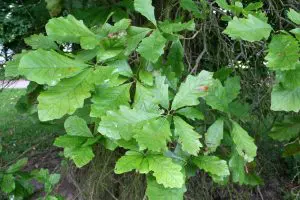 Quercus bicolor, the swamp white oak, is a North American species of medium-sized trees in the beech family. It is indigenous to north, central, and eastern Missouri in moist to swampy locations in bottomlands and lowlands, such as along streams and lakes, valleys, floodplains, and at the edge of swamps.. It can survive in a variety of habitats. It forms hybrids with bur oak where they occur together in the wild. Quercus bicolor, commonly called swamp white oak, is a medium-sized, deciduous tree with a broad, rounded crown and a short trunk which typically grows at a moderate rate to a height of 50-60' (sometimes larger). Leaves are dark, shiny green above and silvery-white beneath, with 5-10 rounded lobes or blunt teeth along the margins. Fall color is yellow, but sometimes reddish-purple. Insignificant flowers in separate male and female catkins in spring. Fruits are acorns that mature in early fall. Also has surprisingly good drought resistance.
Quercus bicolor, the swamp white oak, is a North American species of medium-sized trees in the beech family. It is indigenous to north, central, and eastern Missouri in moist to swampy locations in bottomlands and lowlands, such as along streams and lakes, valleys, floodplains, and at the edge of swamps.. It can survive in a variety of habitats. It forms hybrids with bur oak where they occur together in the wild. Quercus bicolor, commonly called swamp white oak, is a medium-sized, deciduous tree with a broad, rounded crown and a short trunk which typically grows at a moderate rate to a height of 50-60' (sometimes larger). Leaves are dark, shiny green above and silvery-white beneath, with 5-10 rounded lobes or blunt teeth along the margins. Fall color is yellow, but sometimes reddish-purple. Insignificant flowers in separate male and female catkins in spring. Fruits are acorns that mature in early fall. Also has surprisingly good drought resistance. Missouri botanical garden
Wikipedia
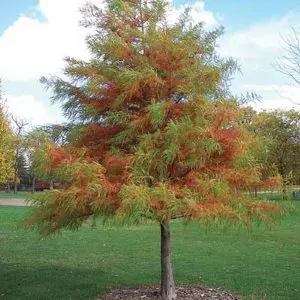 The bald cypress tree is the classic tree of southern swamps. There, in its native habitat, it displays a peculiar habit of raising conical "knees" from its roots. The function of these growths is something of a mystery, although some believe it is a way to help the roots get oxygen. This tree dwells in swamps because it out-competes most other trees on such sites. Unlike most cone-bearing trees, bald-cypress loses its needles each winter and grows a new set in spring. The russet-red fall color of its lacy needles is one of its outstanding characteristics.
The bald cypress tree is the classic tree of southern swamps. There, in its native habitat, it displays a peculiar habit of raising conical "knees" from its roots. The function of these growths is something of a mystery, although some believe it is a way to help the roots get oxygen. This tree dwells in swamps because it out-competes most other trees on such sites. Unlike most cone-bearing trees, bald-cypress loses its needles each winter and grows a new set in spring. The russet-red fall color of its lacy needles is one of its outstanding characteristics. Arbor Day Foundation
Morton Arboretum
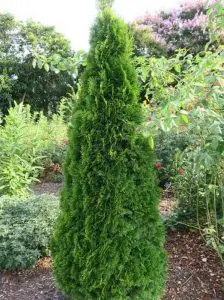 Thuja occidentalis, also known as northern white-cedar, eastern white cedar, or eastern arborvitae, is an evergreen coniferous tree, in the cypress family Cupressaceae, which is native to eastern Canada and much of the north, central and upper Northeastern United States, but widely cultivated as an ornamental plant.
Thuja occidentalis, also known as northern white-cedar, eastern white cedar, or eastern arborvitae, is an evergreen coniferous tree, in the cypress family Cupressaceae, which is native to eastern Canada and much of the north, central and upper Northeastern United States, but widely cultivated as an ornamental plant. Wikipedia Entry
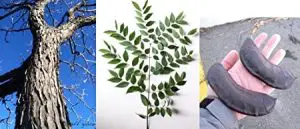 The Kentucky coffeetree's tolerance to pollution and a wide range of soils makes it a suitable tree for urban environments. Native to the Midwest, this tree bears leathery, reddish-brown seed pods that add winter interest to the Midwestern landscape. The seed may be roasted and used as a substitute for coffee beans; however, unroasted pods and seeds are toxic. The wood from the tree is used by cabinetmakers and carpenters. It is planted as a street tree. The expanding leaves are conspicuous because of the varied colors of the leaflets; the youngest are bright pink, while those which are older vary from green to bronze.
The Kentucky coffeetree's tolerance to pollution and a wide range of soils makes it a suitable tree for urban environments. Native to the Midwest, this tree bears leathery, reddish-brown seed pods that add winter interest to the Midwestern landscape. The seed may be roasted and used as a substitute for coffee beans; however, unroasted pods and seeds are toxic. The wood from the tree is used by cabinetmakers and carpenters. It is planted as a street tree. The expanding leaves are conspicuous because of the varied colors of the leaflets; the youngest are bright pink, while those which are older vary from green to bronze.Wikipedia
Morton Arboretum
USDA Plant Guide
Arbor Day Foundation
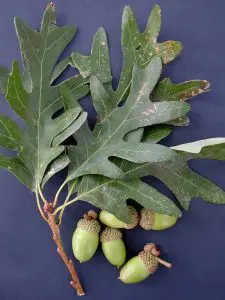 Quercus alba, the white oak, is one of the preeminent hardwoods of eastern and central North America. It is a long-lived oak, native to eastern and central North America and found from Minnesota, Ontario, Quebec, and southern Maine south as far as northern Florida and eastern Texas. Specimens have been documented to be over 450 years old.
Quercus alba, the white oak, is one of the preeminent hardwoods of eastern and central North America. It is a long-lived oak, native to eastern and central North America and found from Minnesota, Ontario, Quebec, and southern Maine south as far as northern Florida and eastern Texas. Specimens have been documented to be over 450 years old. White oak has tyloses that give the wood a closed cellular structure, making it water- and rot-resistant. Because of this characteristic, white oak is used by coopers to make wine and whiskey barrels as the wood resists leaking. It has also been used in construction, shipbuilding, agricultural implements, and in the interior finishing of houses.
Wikipedia Entry
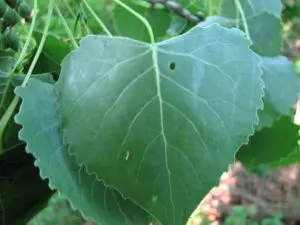 Populus deltoides, the eastern cottonwood or necklace poplar, is a cottonwood poplar native to North America, growing throughout the eastern, central, and southwestern United States as well as the southern Canadian prairies, the southernmost part of eastern Canada, and northeastern Mexico. It is utilized for things like plywood and interior parts of furniture.
Populus deltoides, the eastern cottonwood or necklace poplar, is a cottonwood poplar native to North America, growing throughout the eastern, central, and southwestern United States as well as the southern Canadian prairies, the southernmost part of eastern Canada, and northeastern Mexico. It is utilized for things like plywood and interior parts of furniture. Wikipedia
Illinois wildflowers





